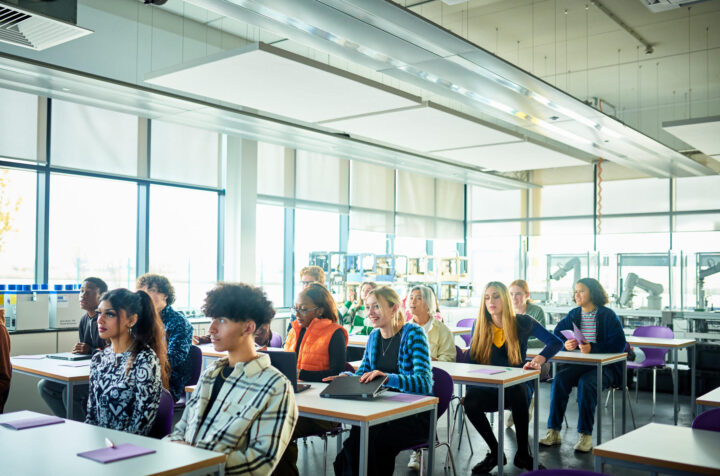Preparing talented STEM students for the ‘real world’ of business turned out to be one of the most challenging, rewarding, and innovative feats of my digital marketing career—and led to a very successful student startup competition and industry awards and recognition.
In 2019, I was approached to teach business and marketing classes at Tesla STEM High School, Washington’s top-rated Washington high school and the nation’s 14th-best in the country (1). Embracing my love for learning and teaching, I became the first business and marketing teacher at the prestigious STEM school and built an entire digital marketing and entrepreneurship curriculum from scratch. Innovation is the heart of the school, and my curriculum helped students market their startup ideas and translate their technical ideas and prototypes into successful business plans.
Entrepreneurial by Design
Though many parents believe that a STEM degree is equivalent to printing money and opening every door, an astonishing 74 percent of people with a bachelor’s degree in a STEM subject are not working in STEM fields (2). These may be some of the smartest bartenders and waitstaff on earth, doing what they can to pay their bills—or they may not have the business acumen to set up and promote their businesses successfully.
The Tesla STEM Choice school was set up to offer gifted students an alternative to traditional high school education. Project-based learning at the core, the school mirrored real-life STEM research and needed the business skills to promote learning.
As the first business and marketing teacher, I not only created hands-on group activities, but I also worked with other STEM teachers to create learning initiatives that incorporated business and marketing tactics to support engineering, labs, environmental science, forensics, and more.
Located in Redmond, a tech hub and Microsoft community, the school was situated in a geographical petri dish for growing budding entrepreneurs. What I did not know when I started was how much I would need to innovate to create engaging lessons, projects, and exams for such gifted students—or the number of hours it would take to accomplish this curriculum.

Evolution of Class Curriculum
My classes included Fundamentals of Marketing, Digital Marketing, and Entrepreneurship (3), and the reality of this trio was that I not only had a steep learning curve but also that many of the industry digital marketing resources were not available to high school students. The students were minors, which meant that website access, and digital marketing tools at the school were limited—with an arduous process for granting exceptions. Being eager and excited I decided to approach setbacks with optimism. I worked with teachers across STEM and Lake Washington School District to partner on immersive, real-world learning projects and goals and introduced guest speakers from different business sectors to tell their stories and provide real-world business examples.
I have always believed these tenants to be true and this was how I designed my class:
Tell me, and I forget.
Teach me, and I remember.
Involve me, and I learn.
Putting the Learning Tenants to the Test
Given my content marketing and storytelling background, I was able to do extensive research, bring in expert industry professionals, design PowerPoint presentations with tool screenshots and information, and brainstorm engaging and relevant hands-on projects. Select students and I even took a field trip to the Tryer Center, Starbucks Innovation Lab, to get inspiration and learn how to go from prototype ideation to business action in record speed (4). According to Warnick, a writer for Starbucks, the Tryer Center is an excellent model for STEM success. She notes, “Starbucks senior leaders, partners, and baristas can hack and hustle there in small, cross-functional teams, moving from words on post-Its, and sketches to real-life prototypes and action in record speed.”
The field trip was a highlight of the year and one of Starbuck’s chief engineers from Tryer Center continues to be involved with STEM and judge competitions today.
The bottom line: By involving the students in research, teaching, group work, and internships, they learned hands-on entrepreneurial and digital marketing tactics and applied their business and marketing fundamentals to their final startup projects.
Final Startup Projects
I designed my course curriculum to lead to a STEM startup project at the end of the year that enabled students to take their learnings from each unit and apply them to their business ideas. They could take any unique idea that inspired them and create a business plan, speech, and video to promote across the school and community. The competition was remote, and I recruited industry professionals to be the judges. The final ten teams involved in the competition received prizes from professionals in STEM fields and many of the students landed internships from their opportunities. Three of the students took their ideas to Microsoft where they won additional competitions and worked with Microsoft on possible branded prototypes.
Education Innovation
I had to be innovative to develop a strategic curriculum that bridged STEM knowledge with practical business skills. I brought professionals and entrepreneurs to the classroom which provided a unique perspective into many areas of business and marketing, including finance, data and analytics UX-UI, content marketing, digital video storytelling, public relations, and entrepreneurship. The students were also able to participate in startup competitions and internship programs through these connections that not only furthered their education but also gave them invaluable opportunities.
(1) Cassidy, Benjamin. “This STEM School in Redmond is Ranked One of the Country’s Best.” Seattle Met: Spring,
2021.
(2) Kennedy, Brian. “6 Facts about America’s STEM workforce and those training for it.” Pew Research Center: April 4, 2021.
(3) Larsen, Dana. Copywriter, Digital Marketer, and Storyteller: Teaching and Classes. Personal Website and Portfolio,
2022.
(4) Warnick, Jennifer. “Inside the Tryer Center: The Starbuck’s Lab Where Anything Is Possible.” Starbucks News:
June 11, 2019.

